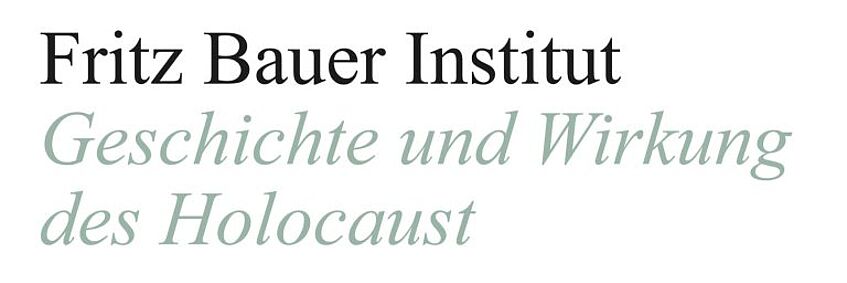Intim und respektabel. Aushandlungen von Homosexualität und Freundinnenschaft in der deutschen Frauenbewegung 1870 bis 1914
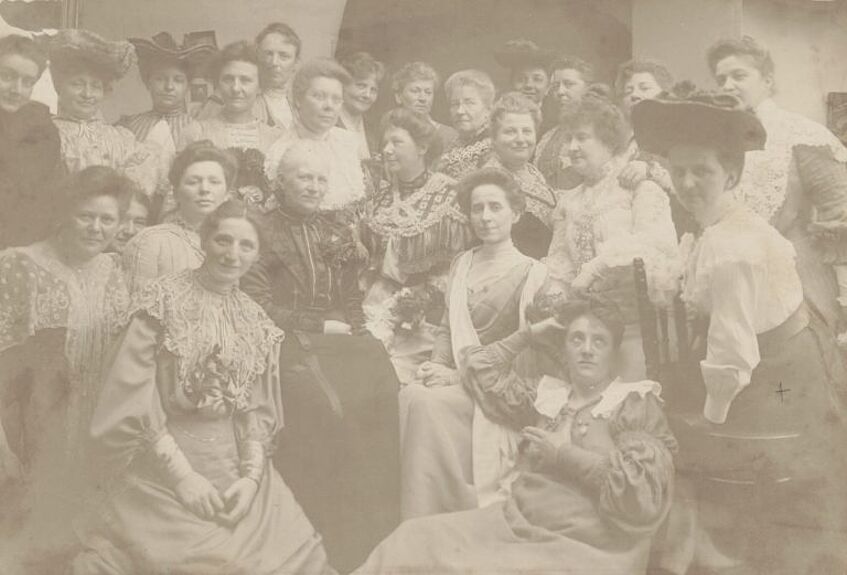
Internationaler Frauenkongress Berlin 1904
Quelle: Nachlass Käthe Schirmacher, Microfiche-Edition 754/013.
Intim und respektabel. Aushandlungen von Homosexualität und Freundinnenschaft in der deutschen Frauenbewegung 1870 bis 1914
Supervisor: a.o. Univ.Prof.in Dr.in Johanna Gehmacher
Project staff: Mag.a Elisa Heinrich
Funding: Uni:docs Fellowship Programme for Doctoral Candidates
Duration: 01.02.2017 – 31.01.2020 - extended until 30/09/2020 (through a completion grant from the University of Vienna)
In the second half of the 19th century, sexology invented a new category of sexual pathology: "female homosexuality". However, this category only became the subject of social debate in Germany when a preliminary draft of the revised Reich Criminal Code of 1909 promised a momentous change: Section 175, which criminalised "unnatural indecency" between men, was to be extended to women. Although the expansion of the offence was not implemented – the Criminal Law Commission decided in 1913 to retain the original Section 175 – the possibility of criminal prosecution of same-sex relationships between women triggered a series of reactions in various public spheres. The women's movement, as a homosocial space in which women – as friends, companions, couples – were connected in professional, political and intimate ways, was uniquely affected by this development.
It is precisely this development that forms the starting point for the present dissertation project. On the one hand, the discourse-historical part examines the discursive negotiation of "female homosexuality" in women's movements from the 1870s to the First World War. In line with a history of sexuality that has increasingly been focusing on different milieus since the mid-2000s, it becomes apparent that the positioning of women's movements in the discourse on female homosexuality has been significantly underestimated to date. The thesis often put forward in research, that the women's movement remained silent on the subject of female homosexuality, can – as this work will show – be questioned on several levels.
On the other hand, the work asks about the social relationships within women's movements and the change in interpretation that took place in them during the period in question. The years of criminal law reform, according to the thesis, represented a phase of intensive negotiation for women's movements, in which the identity constructions and close relationships between women were placed in new, normative contexts of interpretation and different models of intimacy and belonging came into competition with each other. In this socio-historical part of my work, I therefore focus on the life worlds of the female actors and analyse their different strategies and modes of action.
The Youth in the Balkans and their Cultures of Communication, Non-Communication, and their Notions of Reconciliation
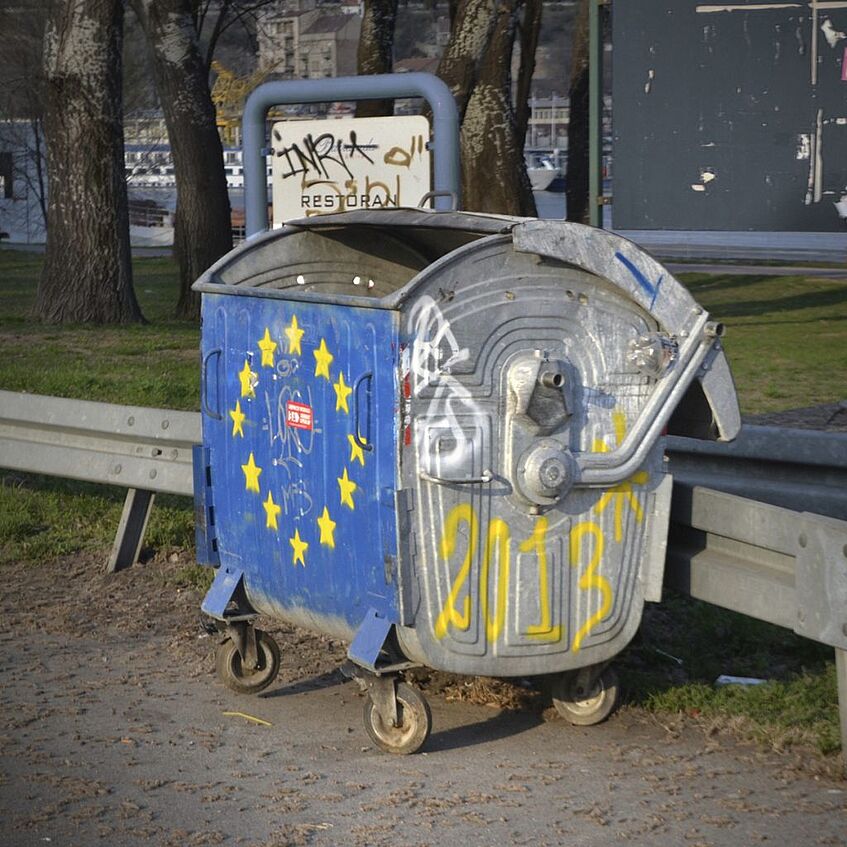
Ⓒ Elisa Satjukow
The Youth in the Balkans and their Cultures of Communication, Non-Communication, and their Notions of Reconciliation
Project Leaders and implementation: Univ.-Prof. Dr. Rainer Gries, Mag.a Dr.in Eva Tamara Asboth Bakk. phil., Mag.a Dr.in Michaela Griesbeck, Julia Anna Schranz, BA BA MA
Funding: Supported by GIZ on behalf of the German Federal Ministry for Economic Cooperation and Development (BMZ)
Duration: 12/2018-12/2020
What makes young people in Southeastern Europe unique? First and foremost, they form an extraordinary generation due to their common burdens – their shared experiences of war often accompanied by flight during their childhoods, and their shared experiences of growing up in political and economic instability in the artificially constructed region of the „Western Balkans“. „Western Balkans“ refers to former Yugoslavia without Croatia and Slovenia, adding Albania.
It is a matter of fact that generations form their very own (sub)cultures to communicate and constitute the essentials and the appearance of “their” generation, even if their cultures of communication separate young people on the basis of their inherited world views and systems of beliefs, probably as a result of the wars. However, we claim that there is a common baseline concerning their past, hence we refer to the young people of Southeastern Europe as members of the Balkan Youth.
Members of the Balkan Youth in our case are young adults between ages fifteen and thirty-five years and live in Albania, Bosnia-Herzegovina, Kosovo*, Montenegro, North-Macedonia and Serbia. According to previous research of the Franz Vranitzky Chair for European Studies, the Balkan Youth can be divided into two main generations: The “Children of the Balkan Wars” on the one hand, and the “Post-War Youth” on the other. The first group was born before or during the wars and shares experiences of war, violence, and/or flight. The latter generation was born in a period dictated by the burden of the aftermath of the wars. We argue that those two generations have experienced different childhoods, but have still built strong ties due to parent-and-child or older-and-younger-siblings’ relationships, as well as similar every-day-life challenges such as education, (un)employment, financial (in)dependence. Employing oral history and life-story interviews, we research the historical, socio-economic, religious, and international contexts they live and lived in, as well as their attitudes towards the Yugoslav Wars of the 1990s and the European idea. Our cooperation partner, the Regional Youth Cooperation Office (RYCO) is operating in the „Western Balkans“ and organizes exchange programs for the Balkan Youth. RYCO is therefore an excellent partner for gaining access to interview partners. We aim to point out the cultures of communication, non-communication, as well as the notions of reconciliation of the members of the Balkan Youth, which are revealing their common and divided memory as well as their transferred, historical, and inherited narratives.
* This designation is without prejudice to positions on status, and is in line with UNSCR 1244 and the ICJ Opinion on the Kosovo Declaration of Independence
Key terms
Cultures of Communication and Non-Communication
Reconciliation
Yugoslav Wars
Oral History
Memory Studies
Youth
Southeastern Europe
„Western Balkans“
Narratives
Transfers
Generation
Studie zu nationalen Geschichtsbildern und demokratischer Disposition
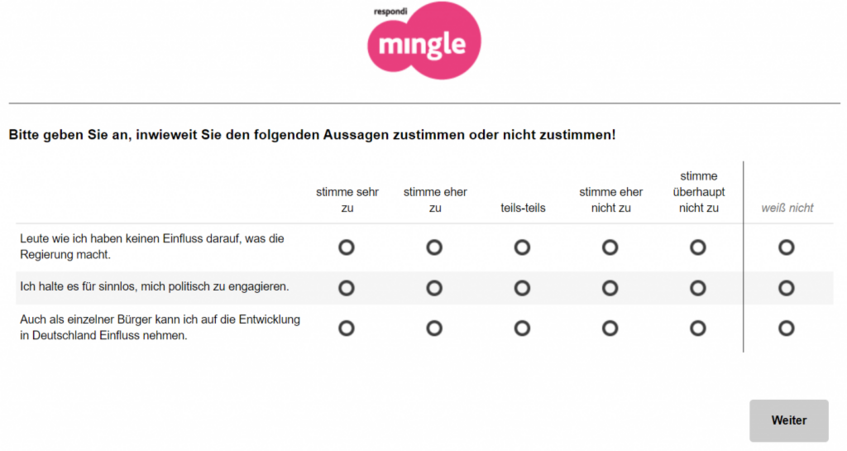
Studie zu nationalen Geschichtsbildern und demokratischer Disposition
Online-Meinungsumfrage zu nationalen Geschichtsbildern und demokratischer Disposition in Deutschland, Frankreich, Italien, Österreich, Polen, der Tschechischen Republik und Ungarn
Project Team:
Department of Contemporary History, Univ.-Prof. Mag. DDr. Oliver Rathkolb
Institut für Staatwissenschaft der Universität Wien, Univ.-Prof.in Mag.a Dr.in Sylvia Kritzinger & Mag. Dr. Julian Aichholzer
Wiener Institut für Arbeitsmarkt- und Bildungsforschung (WIAB), Mag.a Dr.in Petra Ziegler
Fritz Bauer Institut Geschichte und Wirkung des Holocaust der Goethe-Universität Frankfurt am Main, Prof.in Dr.in Sybille Steinbacher
Funding: University of Vienna, Zukunftsfonds der Republik Österreich and Fritz Bauer Institut
Duration: 2019-2020
Study on historical perceptions and democratic dispositions in Austria, the Czech Republic, Germany, France, Hungary, Italy and Poland
The Department of Contemporary History of the University of Vienna, the Department of Government of the University of Vienna and the Viennese Institute for Labour Market and Education Research currently work together on a study dealing with authoritarianism, group-related misanthropy, historical perceptions and democratic dispositions. For this purpose, an online survey is being conducted in Austria, the Czech Republic, Germany, France, Hungary, Italy and Poland by the German survey institute Respondi AG in November/December 2019. The online panel produces representative results using quota samples. For Germany, France, Italy and Poland the sample comprises 2,000 persons; for Austria, the Czech Republic and Hungary 1,000 people will be polled.
The aim of the survey is to investigate and compare authoritarian attitudes, group-related misanthropy and national historical perceptions in Austria, the Czech Republic, Germany, France, Hungary, Italy and Poland. In the analysed countries, there have been political developments in recent years, ranging from electoral successes of right-wing populists, xenophobic and anti-Muslim marches, increasing antisemitism and rejection of refugees to open hatred and bullying against politicians and journalists. The study will collect data on different dimensions and concepts around these issues and will, in addition to the analysis of the respective national attitudes, show by means of a comparison differences and similarities between the countries. Thus, e.g. a distinction can be made between regions as well as cities and rural areas, showing in which areas certain attitudes can predominantly be found. The purpose of the survey is to provide valuable analytical material on the current state and development of authoritarian attitudes in selected European countries, thus providing an important contribution to the socio-political debate and enabling an informed discussion. The survey could also be a first step towards more far-reaching comparative European (or even transatlantic) studies.
If you have questions or would like to know more about the study, please contact Mag. Dr. Petra Ziegler ziegler@wiab.at
Die Geschichte der österreichischen Wasserstraßenverwaltung (1918-1955)
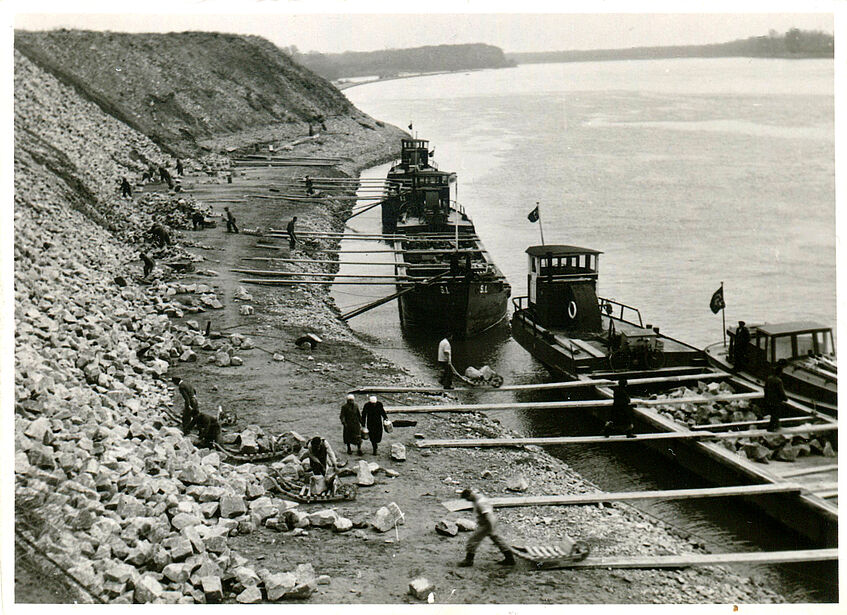
„Befestigung der Uferböschung des Hafens durch Steinschüttung. Blick vom unteren Ende zur Donau“, unbekannter Fotograf. Fotodokumentation zu Hafenbauarbeiten in der NS-Zeit, Album „Hafenbau Albern 1941–1943“ © via donau
Die Geschichte der österreichischen Wasserstraßenverwaltung (1918-1955)
Project Leader: Prof. Dr. Bertrand Perz
Project Staff: Dr.in Alexandra Wachter, M.A. / Gabriele Hackl, M.A.
Funding: via donau – Österreichische Wasserstraßen-Gesellschaft mbH
Duration: 2017–2019
From 1918 to 1955, the administration of Austria's waterways primarily meant the regulation, use and maintenance of the Danube, as well as the administration of flood protection systems and, during the Nazi era, shipping. While individual Austrian hydroelectric power plant constructions have already become the focus of scientific studies, a comprehensive investigation of the history of the Austrian waterway administration and its activities breaks new scientific ground.
The project aims to answer fundamental questions, such as the tasks and function of the authority, as well as the institutional and personnel development across historical caesuras.
The period under investigation allows the effects of the constantly changing political and economic conditions – caused by the collapse of the Austro-Hungarian monarchy, the annexation of Austria by Nazi Germany, the course of the war, the end of Nazi rule and the subsequent Allied occupation – to be traced and thus to show both breaks and continuities. The period from 1918 to 1938 will only be covered briefly. The main focus of the project is on the years 1938 to 1945 and the years of the Allied occupation.
The impact of the military and the needs of the German Reich's war economy on the administration of the waterways is one of the core topics of the project.
For the period of National Socialist rule, specific questions arise, including:
- What role did the Waterways Directorate play in the planning and construction of ports, power plants and canals such as the Danube-Oder Canal?
- What significance did the development of the Danube into a major waterway have in terms of the German Reich's goal of self-sufficiency?
- To what extent did foreign economic expansionist foreign policy goals towards Southeastern Europe, as formulated and advocated by institutions such as the Mitteleuropäischer Wirtschaftstag (Central European Economic Conference), played an important role here?
- What restrictions on construction projects (flood protection, power plant construction, port construction, etc.) occurred in the second half of the war and what impact did aerial warfare have on the administration of waterways?
Furthermore, the tasks and spheres of influence of the individual members of the waterway administration at the managerial level will be examined. Their careers will be traced, as will disputes over authority and the authority's cooperation with other government agencies and private companies. The question of the use of prisoners of war, foreign civilian forced labourers and concentration camp prisoners is also linked to this.
As far as the source material allows, the composition of the remaining staff is also being reconstructed, especially with regard to the ideologically motivated "purges" of the civil service after 1938 and the potential "denazification" after 1945. In addition to the personnel personnel changes, the study also focuses on the destruction, confiscation of equipment, dealings with the various occupation authorities in general, clean-up and repair work, as well as previous "Aryanisations" of the waterways administration properties and reparation efforts during the immediate post-war years.
via donau – Österreichische Wasserstrassen-Gesellschaft mbH commissioned the project team to carry out the study in December 2016, after the feasibility of a research project had been examined in 2015 as part of a preliminary study.
Bilaterale Beziehungen zwischen Österreich und Jugoslawien unter besonderer Berücksichtigung Kärntens
Project Leader: Univ.Prof. DDr. Oliver Rathkolb
Project Staff: Dr.in Petra Mayrhofer
Funding: Altlandeshauptmann Hans Sima Privatstiftung
Duration: 2016 – 2019
Zwangsmigration, Epidemie und Grenze. Grenzentlausungslager der NS-Gesundheitsverwaltung im besetzten Osteuropa 1939-1945
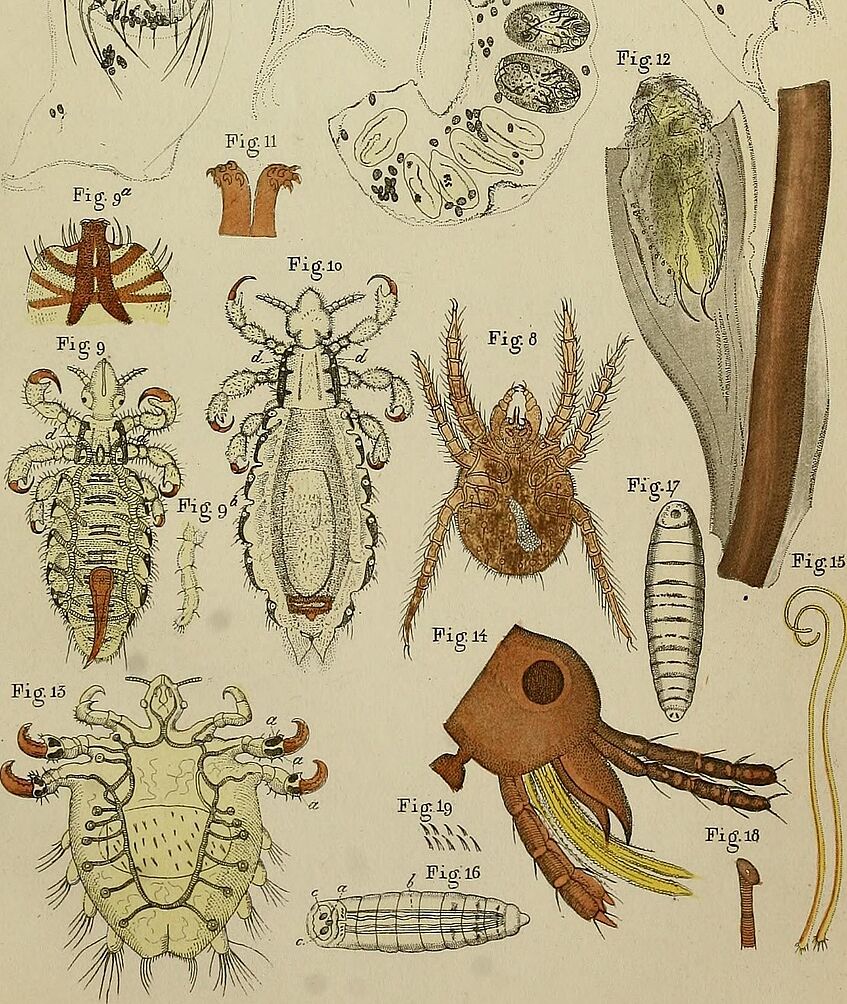
Abbildungen der Kopf-, Kleider- und Filzlaus und ihrer Eier (Fig. 9-13). Vor allem die Kleiderlaus galt als Überträgerin des Fleckfiebers.
In: Friedrich Küchenmeister, Die in und an dem Körper des lebenden Menschen vorkommenden Parasiten. Ein Lehr- und Handbuch der Diagnose und Behandlung der thierischen und pflanzlichen Parasiten des Menschen. Leipzig 1855, S.535.
Zwangsmigration, Epidemie und Grenze. Grenzentlausungslager der NS-Gesundheitsverwaltung im besetzten Osteuropa 1939-1945
Project Leader: Assoz.-Prof. Dr. Bertrand Perz
Project Staff: Mag.a Eva Hallama
Duration: 3/2016 bis 2/2019
Funding: DOC-Stipendium of the Austrian Academy of Sciences
The establishment of the border disinfestation camps
The use of millions of forcibly recruited "civilian workers" from occupied Eastern Europe for the German war economy was not uncontroversial among the Nazi elite. Nazi ideologues warned of the dangers for the German population that would result from the "hiring" of foreign workers. From a public health perspective, the main risk was considered to be the introduction of "dirty diseases" from the east. These included, in particular, typhus. Due to its occurrence in Eastern and Southeastern Europe and its transmission by lice excrement, typhus prevention was also associated with racist ideas of an uncivilised and unclean East. For this reason, the German Reich set up "border delousing camps" in the eastern border area, which forced labourers had to pass through before being deployed in the Reich. This is where the obligatory delousing procedure took place, which was intended to prevent typhus.
From the perspective of the forced labourers, the medical examination and the delousing procedure after recruitment were among the first experiences that marked their transition into forced labour and their subjugation to the Nazi regime. In the analysis of the sources, one focus is on the question of forms of shaming and, in connection with this, on the category of gender. This is because the thesis is based on the assumption that shaming as a structural means of stigmatisation was capable, among other things, of creating boundaries between the "master race" and the "Slavic working people" based on Nazi ideology, which could not be implemented at the spatial level by the forced labour of the Eastern European population within the German Reich.
Methodological approach
A combined approach of discourse theory and praxeology should make it possible to grasp social and institutional practice in its interweaving with social discourses.
Sources from the Nazi administration, in particular the records of the central and local health authorities and labour offices, will be evaluated. By contrast, the analysis of the life experiences and memories of former forced labourers aims to identify and demonstrate the significance of the examination and delousing practices for those affected.
Research questions
- What did the process of being put through the procedure, the registration, examination and delousing practices in the camps look like, and what discourses were interwoven with the institution of the "border delousing camps"? To what extent were security police controls combined with the epidemic-hygienic measures?
- How did former forced labourers experience the process of being channelled through the border delousing camps, and what images do they have of it? What labels were they given in the course of the medical and epidemic-hygienic examinations, and how did they resist them?
Inbesitznahmen. Das Parlamentsgebäude in den Diktaturen zwischen 1933 und 1945
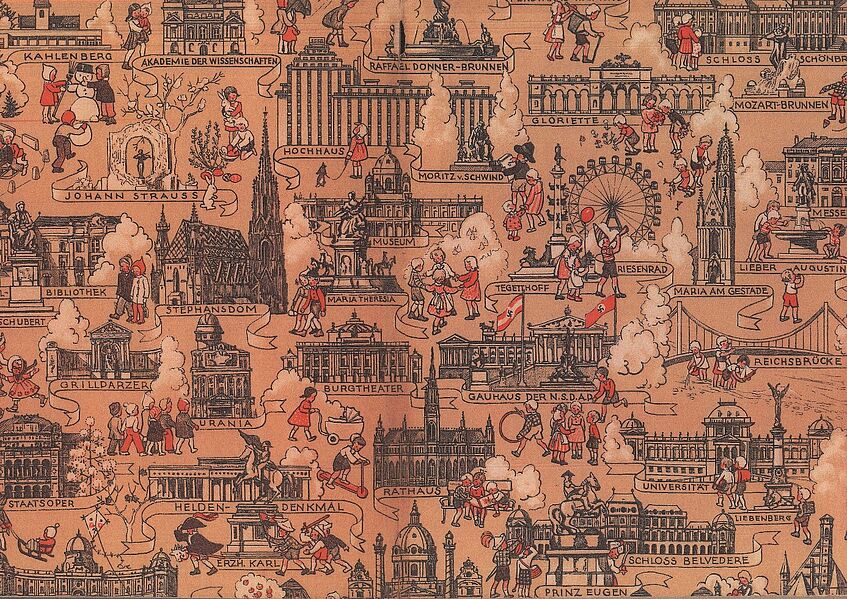
Langer, Franz X. (Hg.), Bei uns in Wien. Leselernbuch für die ersten Klassen der Volksschulen des Reichsgaues Wien, 1. Teil, Wien 1942
Inbesitznahmen. Das Parlamentsgebäude in den Diktaturen zwischen 1933 und 1945
Research project to reappraise the history of the parliament between 1933 and 1945
Project Leader: Assoz.-Prof. Dr. Bertrand Perz
Project Staff: Mag.a Dr.in Verena Pawlowsky / Mag.a Ina Markova
Funding: Austrian Parliament
Duration: 2015–2018
The study's central question is: How did the two anti-democratic systems – the Ständestaat (Corporate State) and the Nazi regime – use parliament between 1933 and 1945? The Parliament building, which was the house of federal legislation during the Ständestaat and initially the seat of the Reichskommissar for Reunification and later the Gauhaus of the Nazi Party after the "Anschluss" of Austria to the German Reich, has never been just a building, but always a symbolic place as well. The use of a magnificent building explicitly dedicated to parliamentarianism for a purpose alien to it in the years when parliamentary structures were suspended in Austria therefore raises several questions.
Since Parliament has always been a centre of power and this significance is, as it were, inherent in it, it is important to determine whether this significance had to be eradicated before the building could be reused or whether it could be transformed for each of the respective purposes. The reconstruction of the structure of the authorities and departments that was implemented in the parliament building after 1933, but especially after 1938, has only been done marginally to date.
As in other cities of the German Reich, there were plans to build a Gauforum in Vienna, but the parliament building would not have been given a function within these plans. The question therefore arises as to why this building was chosen as the Gau house, what discussions and decisions preceded the use of the building, whether there were other fundamental topographical considerations for the location of the party headquarters in the city and what role the Vienna Parliament building would have played in National Socialist urban planning if it had been implemented.
The occupation of a building is usually accompanied by structural adaptations. It is likely that the building was purposefully adapted and that relics from the "parliamentary" period – busts and pictures, but also furniture and carpets – were either destroyed, stolen or relocated due to the war. An analysis of the changes to the architecture and inventory allows conclusions to be drawn about the significance that the corporate state and the Nazi regime attributed to the building.
Questions regarding the specific nature of the building's use as an official seat are also relevant. Especially for the years in which the parliament was the Gauhaus, it must first be analysed whether the Gauhaus was the hermetic seat of an autocratic Gauleitung or an open official and party building that was generally accessible.
This question leads directly to the question of the personnel employed here. Exemplary biographies will show who worked here between 1933 and 1945 and what the workplace of the parliament meant for the protagonists of various political systems and for the long-standing employees – for example, in the office or in building services.
After being used for purposes alien to its original function, the parliament building was re-appropriated after 1945, which was undoubtedly not only an act of restoration, but also an eminently symbolic one. The rebuilding of the new Austria is reflected in the rebuilding of the representative buildings of the re-established state. The parliament building played an important role in the iconology of the reconstruction. The eradication of traces of Nazi rule and of the war damage, the reconstruction of the exterior façade, and the partial modernisation of the interior were all part of this process of reappropriation, which took more than ten years.
The Parliamentary Administration commissioned the project team in 2015 to carry out the study, after – inspired by the provenance research in the parliamentary library (https://www.parlament.gv.at/ZUSD/PDF/NS-Provenienzforschung.pdf– a pilot study was carried out to determine the feasibility of a comprehensive project on the history of the parliament between 1933 and 1945. The President of the National Council, Doris Bures, presented the project at a press conference on 26 June 2015 (https://www.parlament.gv.at/PAKT/PR/JAHR_2015/PK0730/index.shtml).
Antisemitism after the Shoah

Antisemitism after the Shoah
Project Leader: PDin Dr.in Margit Reiter
Project Staff: Mag. Matthias Falter, Mag.a Linda Erker
Duration: 1.9.2014-31.8.2017
Funding: FWF (Project number P 27102-G16)
Despite all the upheavals and changes, the year 1945 was not a "zero hour". Although the Shoah was a decisive turning point in many respects, Anti-Semitism did not disappear without a trace after 1945, but continued to exist in various forms and areas.
The project deals with Anti-Semitism in post-war Austria in general and in the milieu of former National Socialists in particular. To this end, anti-Semitic incidents and statements in the post-war period are reconstructed and analysed in detail. Among other things, the (main) carriers and the target objects of anti-Semitism are questioned. In this context, the two central theses on post-war antisemitism ("antisemitism without Jews" and "antisemitism without antisemites") are also critically questioned. The project examines which old antisemitic clichés and patterns of argumentation have survived National Socialism and which new forms ("secondary antisemitism") can be found after the Shoah? The project also plans a political contextualisation, i.e. the anti-Semitic discourse in the "former" milieu is classified in the general post-war discourse on "Jews". The aim is to identify differences and overlaps, and for the first time critical counter-discourses are also included. Finally, the project also goes beyond the Austrian context. A transnational comparison with post-1945 Germany will be used to identify similarities and differences in the way Jews and anti-Semitism were dealt with in these two post-Nazi states, and to explore possible historical, political and socio-psychological reasons for them.
The project will examine three specific fields of action/levels of discourse of the "former":
1) the private and social level ("internal discourse") using the example of Nazi families and the "Glasenbach",
2) the political level (external discourse) using the example of the VdU and the FPÖ) and
3) the public and media counter-discourse. These different levels of discourse, which partly merge into one another, are compared and linked.
A central aspect of the study is the "double speak" in the milieu of former National Socialists, i.e. the presumed discrepancy between the internal and external discourse with regard to the topic of "Jews" and anti-Semitism.
The period under investigation from 1945-1960 can be seen as an important formative phase in Austria's policy on the past and can be divided into three phases (1945-1947; 1948-1955, after 1955), which are examined in terms of the central research questions. The project is based on a wide range of sources, such as contemporary media (media of former Nazis, general post-war press, Jewish media, etc.), various archive sources (Nazi documents, US Army documents, denazification files, material on the University of enbach, party files on VdU, FPÖ, etc.), autobiographical sources (memoirs of former Nazis, interviews, estates) and published sources, e.g. parliamentary and ministerial council protocols, US reports...).
The study not only fills a considerable gap in research but also makes an empirically and theoretically sound contribution to research on anti-Semitism. The project is intended as a first step towards a comprehensive history of anti-Semitism after the Shoah in Austria, which is still pending.
Die Dachauer Mauthausenprozesse und Österreich
Project Leader: Assoz.-Prof. Dr. Bertrand Perz
Project Staff: Mag. Christian Rabl
Duration: 10/2015 bis 6/2017
Funding: Zukunftsfonds der Republik Österreich
Project implementation at the Österreichische Gesellschaft für Zeitgeschichte
IAEA History Research Project

IAEA History Research Project
IAEA Oral History Project
Project Website
Project Leader: Dr.in Elisabeth Röhrlich
Project Staff: Mag.a Klaudija Sabo
Duration: 2014-2016
Funding: Jubiläumsfonds der Oesterreichischen Nationalbank / Carnegie Corporation of New York
The Creation of the IAEA, 1953-1957
Project Website
Project Leader: Dr.in Elisabeth Röhrlich
Duration: 2015-2019
Funding: FWF, Elise-Richter-Programm
Engagement und Professionalisierung. Käthe Schirmacher (1865-1930)
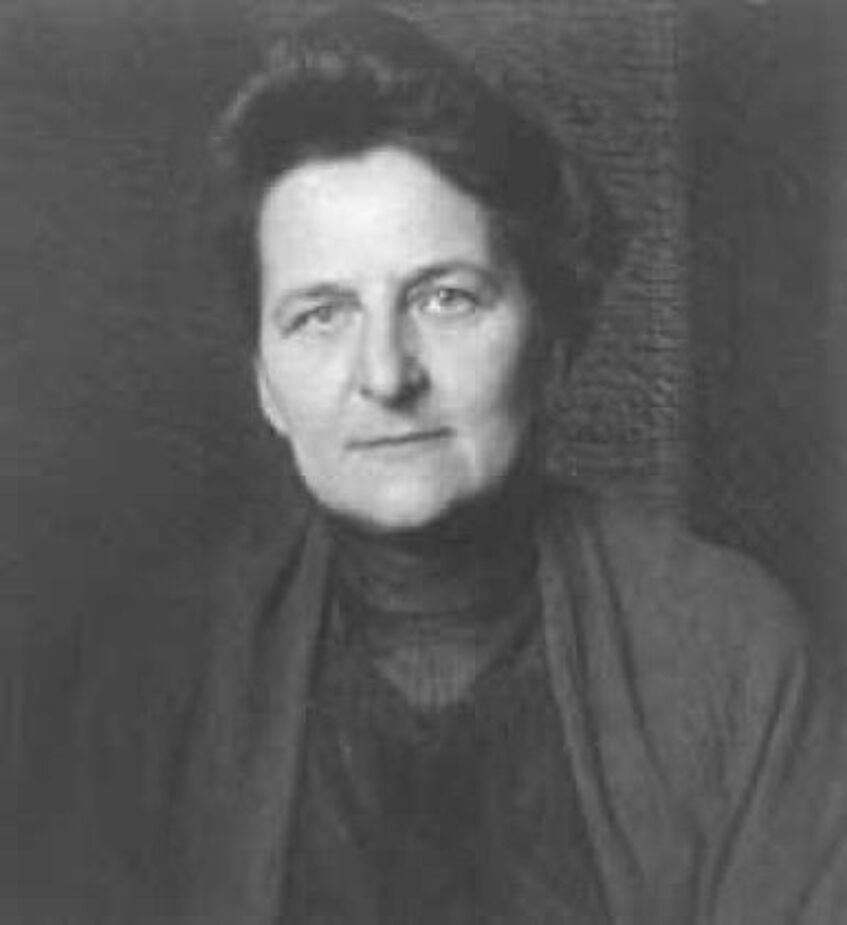
Engagement und Professionalisierung. Käthe Schirmacher (1865-1930)
Selbstentwürfe zwischen radikaler Frauenbewegung und völkischem Nationalismus
Project Leader: a.o. Univ.Prof.in Dr.in Johanna Gehmacher
Project Staff: Mag.a Elisa Heinrich, Dr.in Corinna Oesch
Duration: 01.07.2013 – 30.06.2017
Funding: FWF (Project number P 25705-G16)
Project Website
Around 1900, many women from bourgeois milieus in Europe and North America sought new social positions: young female members of the middle classes increasingly flocked to the labour markets and rejected traditional life plans. The causes for this can be found in the serious socio-structural upheavals of the developing industrial societies with their recurring crises. While the contradictions associated with this were negotiated politically under the topos of the "women's issue", the search for models of female individuality, which was initiated by women's movements, was reflected in terms such as that of the "modern woman", but found resonance, but also resistance, in a much broader social context.
The aim of the project proposed here is to analyse discourses and fields of conflict that gained importance in the context of the transformation of the hegemonic female subjectivisation striven for by women's rights activists. The research questions developed in this context will be examined using the biography and work of the women's rights activist and later nationalist Käthe Schirmacher, who was born in Danzig in 1865, as an example. The case study of a protagonist who was one of the first women in Germany to earn a doctorate and earned her living as an independent book author and journalist will yield innovative theses and results in several research contexts. It will contribute to the history of women's education and careers and allow new theses on the implementation of women's university studies and their integration into higher professions, as well as, in particular, on the gender history of journalism. It will also provide differentiated insights into the international history of the women's movement and open up new perspectives on the history of nationalist movements in Germany at the beginning of the 20th century. The analysis of Käthe Schirmacher's extensive scientific, literary and journalistic writings will provide differentiated insights into specific patterns of interpretation and meaning in the context of these different movements. The project will focus on central questions, including gender concepts and different formulations of the "women's question", as well as the increase in nationalistic and racist identifications in public discourses before the First World War.
In connection with these thematic perspectives, the project will advance the theoretical reflection of biographical research in an interdisciplinary context. Based on concepts developed in, among other things, women's and gender history, newer approaches to biographical research and representation will be discussed and a case will be made for a theoretically reflected inclusion of biographical perspectives in the history of social movements as well as in the history of education. The project will tie in with a current methodological-theoretical proposal to combine discourse-analytical and biographical approaches, and will place a particular focus on the analysis of self-designs and autobiographical texts and the time perspectives inherent in them. The aim of the project is to advance the discussion of open theoretical and methodological questions of biographical research and to develop new forms of biographical writing.
Geschichte der Österreichischen Bundesbahnen von der NS-Zeit bis zum Wiederaufbau in den 1950er Jahren
Project Leader: Oliver Rathkolb
Project Staff: Magdalena Neumüller
Duration: 01.01.2013 - 31.01.2016
Funding: ÖBB-Holding
150 Jahre Wiener Eislauf-Verein
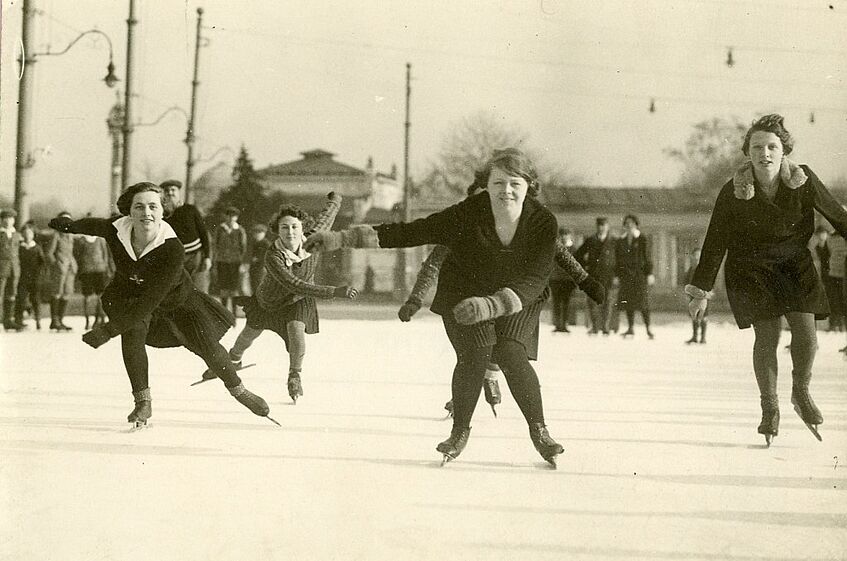
Eisschnellläuferinnen am „Heumarkt“ 1926, © Wiener Eislauf-Verein
150 Jahre Wiener Eislauf-Verein
Die Geschichte des WEV 1867–2017
Project Leader: Univ.-Prof. DDr. Oliver Rathkolb
Project Staff: Mag.a Agnes Meisinger
Duration: 01.01.2014 – 30.09.2016
Funding: Wiener Eislauf-Verein
In 2017, the Wiener Eislauf-Verein (WEV) celebrates its 150th anniversary. Since its foundation in 1867, the club, which has been based on Lothringerstraße near Heumarkt since 1895, has become an integral part of Vienna's sports, leisure and social life. With up to 10,000 members at times (1929/30) and numerous victories by club athletes in international skating competitions, the WEV is one of the oldest, largest and most successful sports clubs in the world. The upcoming anniversary is an opportunity to take a closer look at the 150-year history of the traditional club, especially since there is currently no account of the club's history available to the general public. The aim is to create the first complete work on the history of the Vienna Ice Skating Club from 1867 to 2017.

